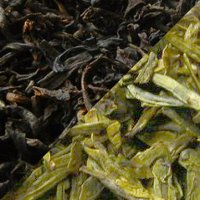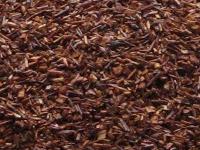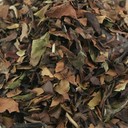Oxidation of Tea
Wikipedia: Tea_processingLast Updated: Mar. 26, 2015
 Oxidation is the main factor distinguishing black from green tea.
Oxidation is the main factor distinguishing black from green tea.What is oxidation?
In a very general sense, oxidation is a chemical process in which atoms lose electrons. Oxidation reactions include such diverse reactions as the burning of fuel, the rusting of metal, and numerous biological reactions. Oxidation can include both normal, healthy biochemical reactions, such as the metabolism of energy sources, and reactions associated with stress or decay, such as oxidative stress.Oxidation in tea production
The oxidation of tea is a key step in the production of tea that radically alters the flavor, appearance, and chemical composition of the tea leaf, and that is instrumental in distinguishing the different types of tea from each other.Oxidized teas, such as black tea and oolong, are processed in a way that bruises the leaf, breaking cell walls and enabling enzymes in the leaves to cause natural oxidation reactions. These reactions are either allowed to carry out to completion, as in the case of most black tea, or are stopped by heating, as in the case of partially-oxidized oolongs. Unoxidized teas, like green tea, are heated earlier in the production process, denaturing the enzymes in the leaf that cause oxidation before the leaves are able to oxidize.
Teas that are not bruised in this manner may still undergo some oxidation, during the time period in between when they are harvested, and when they are heated. Yellow teas, for instance, are allowed to sit while damp, and the yellowing corresponds to a mild oxidation. White teas also oxidize, because their minimal processing does not halt the oxidation process the way the heating does in the case of green teas.
The oxidation process results in profound changes in the flavor, aroma, color, and chemical composition of the tea. As a general rule, tea tends to become darker in color as it oxidizes, due to the presence of tannins, dark chemicals absent in unoxidized tea. It is hard to generalize about flavor: both oxidized and unoxidized teas alike can be either mild or strong, bitter or smooth. However, the aroma of teas changes dramatically. Unoxidized and less oxidized teas often tend to have more grassy, vegetal, and herbaceous aromas, similar to those of fresh leaves, as the chemical composition of these teas are closer to those of fresh leaves.
Tea, like most fresh foods from plant-based sources, is rich in antioxidants, chemicals which often inhibit or serve as a buffer against oxidative stress. When tea is oxidized during production, the antioxidants are transformed but not destroyed, although the Vitamin C (which is one type of antioxidant) does tend to be destroyed. The page on antioxidants in tea explains this in more depth.
Tea types and their level of oxidation
The oversimplified explanation of the oxidation of tea that is usually given is that black tea is fully oxidized, whereas green tea is unoxidized, and oolong tea is partially oxidized or semi-oxidized. However, this explanation is not strictly true for all examples of these teas.Also, the different classes of teas are not fully characterized by their oxidation level. That is, there are many semi-oxidized teas that are not oolongs, fully-oxidized teas that are not black tea, and unoxidized teas that are not green teas. Although level of oxidation is an important quality in distinguishing the different classes of tea from each other, we classify tea primarily based on its production method and not strictly on its oxidation level.
- Black teas are usually described as being fully oxidized. However, numerous teas high-grown teas, especially those from the Himalayan region like Darjeeling first flush teas, have a greener character, and are better described as partially oxidized teas. The greener color comes from a hard wither, meaning a withering process which completely dries out certain portion of the leaf, effectively preventing it from oxidizing. In some rare cases these "black teas" can even be as light (and green) in color as green teas. These hard withers are easier to carry out during cooler and drier periods, and at higher altitudes, which explains why second flush teas are darker, and why "greenish" black teas are absent from lower-altitude regions like Assam.
- Green teas are usually described as being completely unoxidized. However, some green teas can sometimes exhibit a slight or partial oxidation. Although not part of the production process, green teas that have been stored for long periods of time can also darken due to oxidation.
- Oolong teas are usually described as semi-oxidized. However, the level of oxidation in oolongs can vary from almost none, creating teas such as pouchong, with a vibrant green color like green tea, to almost full, creating teas just as fully oxidized as some black teas. Assessing the level of oxidation of oolongs is further complicated by the fact that the level of roast varies highly among oolongs, and some less oxidized oolongs can appear dark in color due to a higher level of roast.
- White teas are usually described as unoxidized teas, like green teas. However, because of their minimal processing which does not kill the enzymes in the tea leaf as happens in the processing of green tea, white teas naturally experience some oxidation, so as a general rule, they are slightly more oxidized than typical green teas. This oxidation tends to be greatest in the larger-leafed white teas, because these leafs retain moisture (and thus stay biologically active) for a longer time during the withering process.
For this reason, white teas made out of larger leaves, such as white peony, shou mei, and moonlight white, tend to be more oxidized than those made exclusively out of leaf buds or smaller leaves. In the case of the larger-leaf white teas, teas harvested in an unusually dry season will tend to be less oxidized, as the leaves will contain less moisture and dry out more quickly.
Because of their minimal processing, the oxidation of white teas also continues more quickly during storage than it does for green teas; as they are stored, white teas can darken considerably in color and change in flavor as well. - Yellow teas are processed similarly to Chinese green teas, but with an extra production step in which the leaves are allowed to sit while damp. This produces a mild, partial oxidation.
- Pu-erh teas are rather complex with respect to oxidation. Raw, or sheng Pu-erh can be considered a type of green tea, as it is heated to prevent oxidation. The aging process for Pu-erh, while very different from the type of oxidation carried out in most tea production, does involve oxidation, and does generally result in a darkening of the tea.
Ripened, or shu Pu-erh, on the other hand, is usually considered a fully oxidized tea. The process used to create shu Pu-erh, called wet piling, is very different from normal black tea production, but it does lead to a full oxidation of the leaf (including a very dark color), leading some retailers to classify these teas as "black teas". - Traditionally scented teas produced by repeated layering of a base tea with flowers, such as jasmine tea or osmanthus tea tend to be slightly more oxidized than their unscented base teas would be, because the scenting process produces additional oxidation.
Measuring oxidation and subjective descriptions of oxidation level
It is possible to quantify the oxidation of teas by measuring the portion of various unoxidized chemicals and their oxidized counterparts. For example, catechins become theaflavins upon oxidation. However, because laboratory studies are costly, tea companies selling semi-oxidized teas usually make a subjective estimate of oxidation level of their teas based on color and flavor, or what is known of their processing, such as claiming that a particular oolong tea is 30% oxidized or 70% oxidized. These claims are usually arbitrary estimates, but can be good coarse indicators of the character of a particular tea.Oxidation of herbal teas:
 (Red) rooibos is allowed to oxidize in its production, much like how black tea is oxidized.
(Red) rooibos is allowed to oxidize in its production, much like how black tea is oxidized.The two most common examples of herbal teas allowed to oxidize like tea are rooibos and honeybush, both of which originate in South Africa. Both of these herbs are traditionally processed by methods that allow them to fully oxidize, turning them a rich red color. Both of these herbs can also be processed in ways inspired by green tea production, heating them to prevent oxidation. This leads to green rooibos and green honeybush, which shares some characteristics in common with green tea.
Further reading on the oxidation of tea:
Oxidation (fermentation), an article by the Tea Research Association.
What is Oxidation? by Tony Gebely of Chicago Tea Garden.
Oxidation of Tea 101 by Pei of Teanamu.
Oxidized or Fermented Tea? by Adam Yusko on the English Tea Store Blog.





